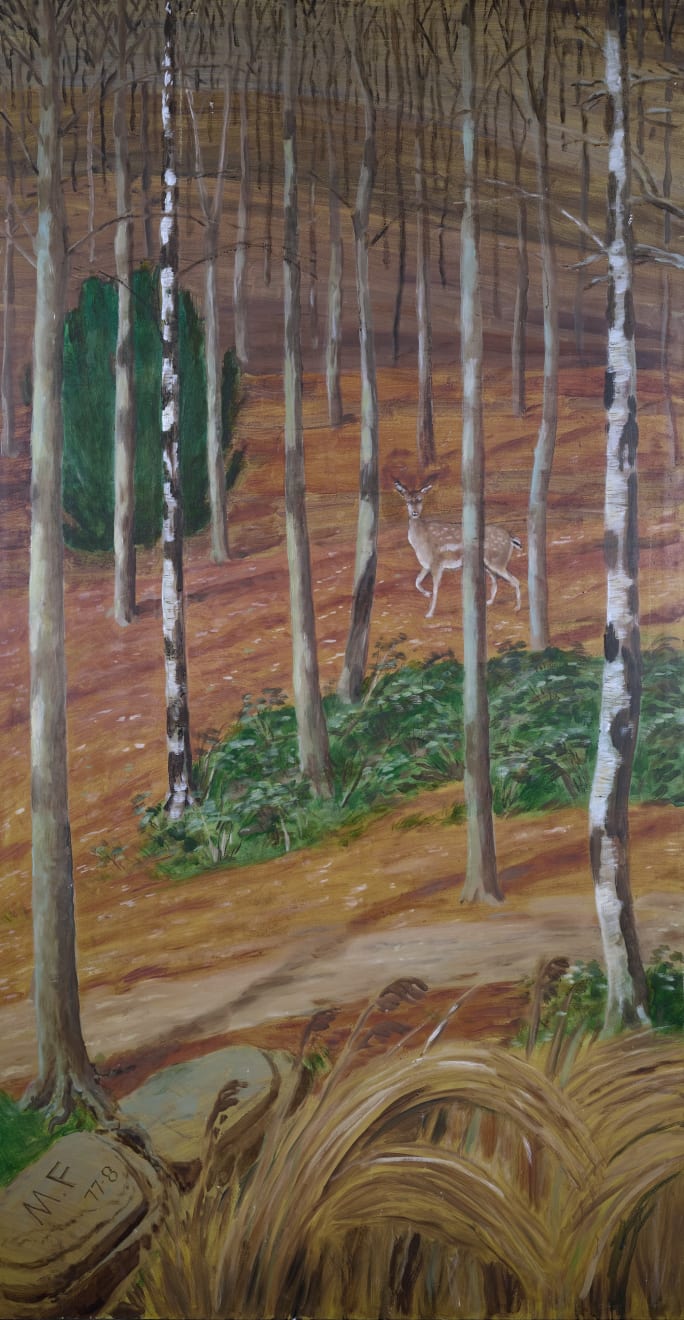Open a larger version of the following image in a popup:
 Maxwell Fry, frieze hanging at Wykehurst Park, Sussex
Maxwell Fry, frieze hanging at Wykehurst Park, Sussex
 Maxwell Fry, frieze hanging at Wykehurst Park, Sussex
Maxwell Fry, frieze hanging at Wykehurst Park, Sussex
Edwin Maxwell Fry
Forest with a Herd of Deer - A Four Panel Frieze
oil on board, in 4 parts
each panel: 215 x 113cm; 84 3/4 x 44 1/2in
all: 215 x 452cm; 44 1/2 x 178in
all: 215 x 452cm; 44 1/2 x 178in
signed with initials and dated 77-8 lower left
Further images
In the present panoramic frieze trees stand bare upon a mottled ground of rusty oranges and reds, interrupted by flowing green hedges, their undulating forms contrasting with the rigid, monotonous...
In the present panoramic frieze trees stand bare upon a mottled ground of rusty oranges and reds, interrupted by flowing green hedges, their undulating forms contrasting with the rigid, monotonous lines of the tree trunks. Across the rising landscape a herd of deer roam, some grazing whilst two stand alert, gazing out at the viewer.
The displacement of the receding trees and the deer are reminiscent of The Hunt in the Forest by Paolo Uccello (1397-1470) in the Ashmolean Museum, Oxford, a masterpiece in linear perspective. In like manner, Maxwell Fry combines the symmetry and rhythmic punctuation of the trees with the asymmetrical flow of the organic shapes that make up the landscape, to create a painting that reflects the contrasts found in nature.
Architect as well as artist, Maxwell Fry headed up an influential London practice with his wife Jane Drew, the couple winning prestigious commissions pre- and post the Second World War, and working with Le Corbusier in the 1950s to create the new capital city of Punjab at Chandigarh, India. First introduced to Le Corbusier's architectural principles by Canadian designer Wells Coates, Maxwell Fry incorporated many of his ideas into his own designs, including his five 'points' of architecture.
One of Le Corbusier's dictums was the inclusion of pilotis (thin columns) into the structural support and composition of a building, a feature that Maxwell Fry translated into the vertical trunks of the trees in the present composition.
Maxwell Fry designed many London houses, ranging from Kensal House in Kensal Rise, a development of sixty-nine flats, to the ultra-modernist homes Miramonte in New Malden and Sun House in Hampstead, all of which feature subtle curves alongside solid lines, which was a pivotal feature of Maxwell Fry's work. Whether building or painting, he emphasised beauty in contrast, both natural and manmade.
The displacement of the receding trees and the deer are reminiscent of The Hunt in the Forest by Paolo Uccello (1397-1470) in the Ashmolean Museum, Oxford, a masterpiece in linear perspective. In like manner, Maxwell Fry combines the symmetry and rhythmic punctuation of the trees with the asymmetrical flow of the organic shapes that make up the landscape, to create a painting that reflects the contrasts found in nature.
Architect as well as artist, Maxwell Fry headed up an influential London practice with his wife Jane Drew, the couple winning prestigious commissions pre- and post the Second World War, and working with Le Corbusier in the 1950s to create the new capital city of Punjab at Chandigarh, India. First introduced to Le Corbusier's architectural principles by Canadian designer Wells Coates, Maxwell Fry incorporated many of his ideas into his own designs, including his five 'points' of architecture.
One of Le Corbusier's dictums was the inclusion of pilotis (thin columns) into the structural support and composition of a building, a feature that Maxwell Fry translated into the vertical trunks of the trees in the present composition.
Maxwell Fry designed many London houses, ranging from Kensal House in Kensal Rise, a development of sixty-nine flats, to the ultra-modernist homes Miramonte in New Malden and Sun House in Hampstead, all of which feature subtle curves alongside solid lines, which was a pivotal feature of Maxwell Fry's work. Whether building or painting, he emphasised beauty in contrast, both natural and manmade.
Provenance
Ebrahim Golestan, Wykehurst Park House, West SussexBy descent to the present owner
Ebrahim Golestan, 1922-2023, was friends with Maxwell Fry from whom he commissioned the present work. The four panel frieze hung at Wykehurst Park House, West Sussex his home until he died, just short of his 101st birthday. An Iranian film maker and writer, Golestan was closely associated with the poet Forough Forrokhzad, 1934-1967. He produced her acclaimed film The House is Black in 1963, the same year that he made the Iranian classic Brick and Mirror. The last film he made in Iran was Ghost Valley's Treasure Mysteries in 1974.










